
Viscosity is the measurement of the resistance of a fluid to deformation or change. The fluid can be a liquid or a gas, and it is pretty easy to see that the liquids are thicker than the gases, and have greater viscousities. The viscosity of some liquids is also higher than others. For instance, honey or syrup is thicker than water. Deformations and changes are brought about by stress, which is usually a force. Viscosity occurs due to friction between the molecules which are moving at various speeds in a particular fluid. Naturally, fluids move away faster from the walls of a container, and the fluids move more gradually the closer they get to the wall.
Investigating Fluid Viscosity : Materials and equipment needed
- Tall graduated cylinder
- Stopwatch
- Marble
- Honey
- Syrup
- Glycerin
- Liquid glue
- Water
- Any other liquids you wish to test!
- Pen and Notebook
Process
- Fill the cylinder with one of the liquids and leave a few centimeters to prevent it from overflowing. Ensure that you fill every cylinder to the same height every time.
- Hold your marble at the top of the cylinder using one hand and your stopwatch using the other hand.
- Drop the marble and begin the stopwatch simultaneously.
- When your marble touches the cylinder’s bottom, stop the timer.
- Note the name of each liquid you tested, its original height, and how long the marble took to get to the bottom of the cylinder in seconds.
- Repeat this experiment two more times for every liquid to get enough data to calculate an average. Once you finish, compute the average time using the equation outlined below.
Average time = (time one + time two + time three) / 3
- Evaluate the average velocity of this marble via the liquid. The total distance is the liquid’s height, and the time used will be the average time you calculated in Step six. Use this equation to calculate the velocity.
Velocity = distance / average time
- Repeat this experiment by testing the other liquids.
Outcome
Viscosity from highest to least will be Liquid glue, honey, glycerin, syrup, and lastly water. However, remember that your viscosity lab may have generated some variance depending on the type of every product you use. At times you will realize that some types or brands might be less or thicker than others.
To compare the proportional viscosities of liquids, you will make it easy to utilize the computed velocities. The liquids in which a marble had the slowest velocities had the highest viscosities. Filling your graduated cylinder with the similar amount of liquid every time is not primarily essential to computing the velocity correctly, but it makes the calculations pretty easier if you utilize a similar number for every distance value.
Conclusion
The friction between the fluid molecules resists fluid deformation and change. The weight of your marble, which is also the gravitational force, will also cause stress on your liquid. The high viscosity fluids such as glue and honey resist the changes brought about by these forces are usually the best.
Liquid viscosity is usually temperature sensitive, with many gases and liquids becoming less viscous as they warm up. To take this test further, you can try microwaving your liquid for a short duration of time to check if the marble will drop through quicker when the liquid is heated up.
